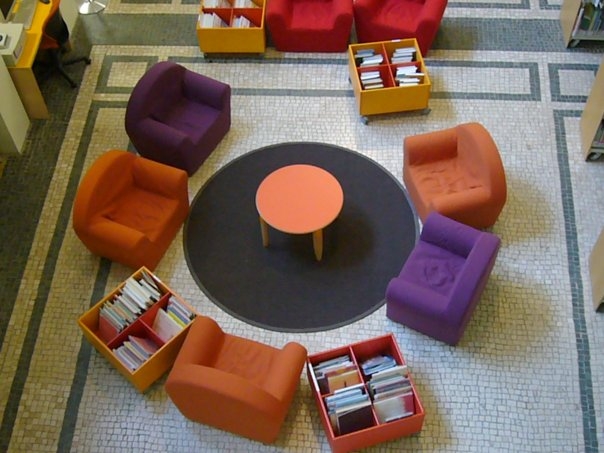Technology for Teenagers in an Italian Library: What Changed During the Covid-19 Emergency?
Interview by Naoko Nakajima Koseki (Chief Planning and Cooperation Division, International Library of Children’s Literature, National Diet Library, Japan) to Nicoletta Gramantieri (Biblioteca Sala Borsa, Bologna, Italy)
Supported by Antonella Lamberti (Children’s Librarian, Biblioteca Comunale Tiziano Terzani, Italy)
Introduction
Naoko Nakajima Koseki visited Bologna in March 2014 and its Sala Borsa Library.
At that time, Nicoletta Gramantieri kindly guided her around the Library. This tour was very impressive for Mrs. Nakajima because the library offreed an independent place for young adults, called “Officina Adolescenti”. There were digital equipment and media to encourage young people to express themselves in the newest way.

Now, that the libraries services all over the world were pulled to improve their digital offers because of the pandemic, in late December 2020 Mrs. Nakajima is interviewing Nicoletta Gramantieri about the changes in those activities for teens and young adults at Salaborsa in Bologna since 2014.
Q: When did Salaborsa library start to provide digital media for young people?
A: Since its opening in 2001 Salaborsa Ragazzi was defined as a “multimedia library”. Ofcourse its multimedia offer has become wider as the years went by.
At the beginning there was the possibility to use Internet and navigate, then it was added that one of playing video games, using apps selected by librarians both for children and young adults, and there has been coding classes. Since 2012 children have at their disposal a service of digital lending, that offers a free access to a variety of e-books for children, audio books, music and other online contents, to be read or listened to by using PC, tablets, smartphones, e-book readers and other devices.
Q: How have you been teaching the users how to use digital media? Have you ever planned workshops for young people or their guardians?
A: During the years we have especially organized events about coding. We had already planned weekly workshops about coding, robotics, augmented reality to be held in the library as soon as it will be open to the public again.
Last year in the frame of a project of promotion of reading for 0-6 years children, involving libraries, nurseries, preschool and kindergartens, an educational course to facilitate the creative use of tablets and apps in educational context was realized..
The project also consisted in delivering a tablet to each library in town and to each one of the 31 educational services. Last month we held a supplementary course online course about these topics.
Q: I saw a video of Adolescenti on YouTube and I found it very interesting and exciting. Is Adolescenti managed by young people themselves? Or have some adults or specialists been helping or guiding them?
A: “Officinadolescenti” (that means “Teenagers laboratory”) is a space in Salaborsa Library where two professional educators work with the goal of meeting the cultural needs of children and for realizing together with them cultural projects. The following one is the website for information about OfficinaAdolescenti
In OfficinaAdolescenti there is a room for recording and there are also posts for video editing that can be booked and used by teenagers.
At the most OfficinaAdolescenti has also a brand for the musical production (OARecords) and several troupes in charge of video making (OAMovie). In that space different kinds of workshops (art, theatre, dance) take place. Here is the Youtube channel with the music produced by OAR records
Q: What has changed or what is new in those activities nowadays after COVID-19?
A: At present the library is still closed. We only have a loan service working, but the requests for borrowing are operated online. If somebody doesn’t want to come to the library, there’s the possibility to make a request for books delivered at home or as well for using the digital library.
The reference service is made online through video calls to be booked with the librarians by users of any age target: families, children, teenagers. The librarians go around the shelves and in the library rooms with a tablet in the hand that they use for showing books, DVDs, magazines and audio books and they give suggestions. These calls usually end with the list of the requests of books to be borrowed that the user will find available in the library or, better, will have delivered at home.
The activities of OfficinaAdolescenti now take place outside of the library, in spaces dedicated to educational activities that do not have to accomplish to the limitations due to this closure,
The “Reading club” of teens from 11 to 1 years has been moved online, as well as the educational meetings with the volunteers, the teachers and the colleagues from other libraries. It’s still early to understand how these practices will affect the library, its activities and its services when all the limitations will be over.
Q: Would you please tell me your personal idea about providing digital media for young people referring or comparing to traditional paper book reading?
A: I think that information literacy and access to digital sources are among the goals of the public libraries, and that the libraries should do a sort of “democratic” work for everybody, with the purpose to have everybody able to have access to digital and to develop their skills for using technologies in an active way.
Q: What do you think is useful in using digital media for young people in this hard time under Covid-19?
A: I don’t have any answer for this question. But I think that the answer that the library can give is in its services, that in this period we had to change “re-thinking” them.